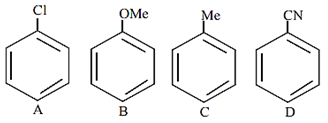 Multiple Choice Questions
Multiple Choice QuestionsIncreasing order of reactivity of the following compounds for SN1 substitution is:

(B) < (C) < (D) < (A)
(A) < (B) < (D) < (C)
(B) < (C) < (A) < (D)
(B) < (A) < (D) < (C)
The major product of the following reaction is
CH3C≡CH
CH3C (I) Cl CHD2
CH3CD (Cl) CHD (I)
CH3CD2CH(Cl) (I)
CH3CD(I)CHD (Cl)
A.
CH3C (I) Cl CHD2
The major product is
The increasing order of reactivity of the following compounds towards aromatic electrophilic substitution reaction is

D < A < C < B
B < C < A < D
D < B < A< C
A < B < C < D
Increasing rate of SN1 reaction in the following compounds is :

(B)<(A)<(C)<(D)
(A)<(B)<(D)<(C)
(B)<(A)<(D)<(C)
(A)<(B)<(C)<(D)
